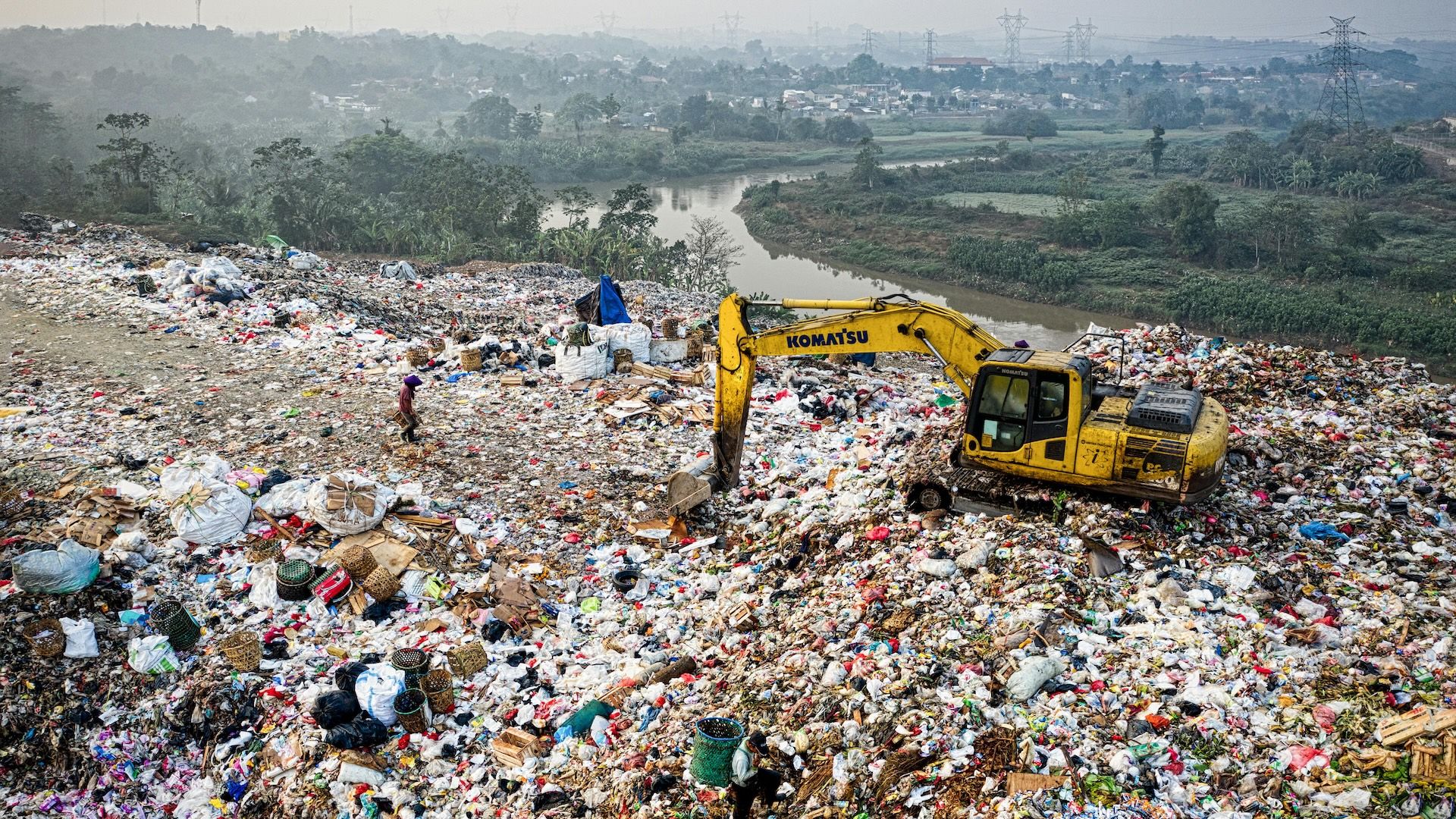Understanding the major non-GHG air pollutants

Since our first data release in 2021, Climate TRACE has tracked greenhouse gas (GHG) emissions --- carbon dioxide (CO2), methane (CH4), and nitrous oxide (N2O), as well as CO2e-100yr and CO2e-20yr --- providing a powerful tool for accelerating climate action. With the November 2024 data release, we began covering key non-GHG air pollutants for all sources of human-caused emissions --- including pollutants that are implicated in millions of deaths around the world each year. As of late September 2025, PM2.5 emissions are now visualized as animated plumes from sources in and around thousands of major urban areas globally.
According to the World Health Organization, nearly the entire global population (99%) breathes air with pollutant levels above WHO guidelines, with the highest exposures in low- and middle-income countries. Many of these pollutants are released alongside GHGs from sources like fossil fuel combustion. In this article, we take a closer look at the eight major non-GHG co-pollutants Climate TRACE now tracks, including where they come from and how they threaten human health.
What are non-GHG co-pollutants?
Non-GHG co-pollutants are harmful pollutants released alongside greenhouse gases from sources like power plants, factories, and vehicles. Unlike GHGs, which primarily contribute to climate change, these co-pollutants directly impact human health and the environment.
Which non-GHG pollutants does Climate TRACE now cover?
Particular Matter (PM2.5) Particulate matter 2.5 (PM2.5) is made up of tiny airborne particles with diameters of 2.5 microns or less, making them small enough to penetrate deep into the lungs. This fine particular matter often comes from the burning of gas, oil, diesel fuel, or wood. In regions where wood and charcoal three-stone fires are common, cooking is also a major source of PM2.5.
Exposure to PM2.5 has been linked to numerous health issues, especially affecting sensitive groups like children, older adults, and people with respiratory or cardiovascular conditions. Inhaling PM2.5 can lead to respiratory symptoms, asthma attacks, bronchitis, and even premature death.
See PM2.5 plumes in animated visualizations here.
Carbon Monoxide (CO) Carbon monoxide (CO) is a colorless, odorless, and poisonous gas released when carbon-based fuels are burned incompletely or inefficiently. In general, cars, trucks, and other machines that burn fossil fuels are the biggest source of carbon monoxide pollution, although levels vary globally based on location and season. For example, agricultural fires drive CO emissions in regions like Africa and Southeast Asia, while in the US, Europe, and eastern China, urban vehicle and industrial emissions are the key sources.
Most people are familiar with the danger of inhaling CO in closed indoor environments. In high concentrations, it can reduce the amount of oxygen that can be carried in the bloodstream, leading to dizziness, confusion, unconsciousness, and even death. In terms of outdoor air pollution, elevated CO levels heighten risk for people with heart disease.
Organic Carbon (OC) Organic carbon (OC) is an anthropogenic reactive carbon compound emitted from human activities like fossil fuel combustion and volatile chemical products. It acts as a precursor for secondary pollutants including ozone and fine particulate matter. Major sources of OC include emissions from transportation like cars, trucks, planes, ships, and train engines, as well as from industrial products including pesticides, adhesives, and cleaners. These carbon compounds can exist in different volatility states, transforming in the atmosphere and contributing to air pollution.
Black Carbon (BC) Black carbon (BC) is a fine particulate matter commonly known as soot that's formed through incomplete combustion of fossil fuels, biofuels, and biomass. Major sources include wildfires, residential wood burning, agricultural waste burning, and incomplete fossil fuel combustion.
Inhaling high concentrations of these tiny particles can contribute to heart, circulatory, and respiratory disease, and prolonged exposure is linked to premature death. Studies also show that black carbon may carry other various toxic chemicals harmful to human health. Black carbon also exacerbates climate change because it absorbs light and warms the atmosphere.
Volatile Organic Compounds (VOCs) Volatile organic compounds (VOCs) are chemicals that easily evaporate into the air and are commonly found in industrial products and fuels. Major sources include emissions from petroleum fuels, industrial solvents, and water treatment by-products. Although VOCs are also found in household products, their greater environmental impact comes from industrial and fuel-related sources, where they contribute to air pollution and pose health risks.
Over time, exposure to VOCs can lead to issues with the lungs, central nervous system, kidneys, and liver. They have also been linked to an escalated risk of cancer.
Sulfur Dioxide (SO2) Sulfur dioxide (SO2) is a colorless gas with a sharp, irritating odor, generated typically from burning fossil fuels and smelting sulfur-containing mineral ores. Natural sources like volcanic eruptions also release sulfur dioxide into the atmosphere. When SO2 combines with water and oxygen, it forms sulfuric acid, the main component of acid rain, which is harmful to forests and waterways.
Exposure to SO2 can have serious respiratory effects, especially for people with asthma or chronic respiratory conditions. The gas irritates the respiratory tract, often causing symptoms like coughing, excess mucus production, and eye irritation. In the long term, sulfur dioxide exposure can increase risk of respiratory infection and exacerbate conditions like asthma and bronchitis.
Nitrogen Oxides (NOx) Nitrogen oxides (NOx) refer to a mix of gases --- nitric oxide (NO) and nitrogen dioxide (NO2) --- which are produced from cars and trucks, industrial processes, and natural sources. While NO is colorless, it reacts in the atmosphere to form NO2, a corrosive gas with a sharp smell that contributes to the yellow-brown color of smog.
Exposure to high levels of nitrogen dioxide can irritate the respiratory system, worsen asthma, and increase risk of respiratory infection. Long-term exposure is linked to chronic lung disease and can dull the senses, reducing a person's ability to detect certain smells. In 2021, 52,000 premature deaths were linked to chronic exposure to NO₂ in the EU.
Ammonia (NH3) Ammonia (NH3) is a colorless gas released into the atmosphere primarily from food production activities like livestock farming and fertilizer use, with agriculture contributing up to 85% of anthropogenic ammonia emissions. Other sources include industrial processes, catalytic converters, landfills, and sewage processes.
Direct exposure to ammonia is known to irritate the respiratory system, especially for those who work closely with livestock. Common symptoms include throat and eye irritation, coughing, and increased mucus production. There is also emerging evidence that ammonia exposure may increase the risk of asthma in children living near agricultural areas, highlighting the compound's potential to affect both immediate respiratory health and long-term lung function in vulnerable populations.
The importance of tracking non-GHG co-pollutants
Non-GHG air pollutants pose a clear threat to human health, yet until now, the world has lacked current, globally available data at the plant level. This data has been urgently needed to better characterize the sources of pollutants and make policies to mitigate that pollution. By understanding the relationship between greenhouse gas sources and their impact on human health, we can develop more comprehensive strategies to address both climate change and public health concerns. This expanded data coverage enables users to better evaluate and respond to the full environmental and health impacts of pollution sources worldwide.
The methodology for how non-greenhouse pollutants were estimated is available here. This methodology is Climate TRACE's 'Tier 0' approach, with plans to improve the methodology, underlying assumptions, and data sources in future iterations. This work grew from an initial scoping study supported by the Clean Air Fund on how Climate TRACE could leverage its source-level database to estimate non-GHG co-pollutants.
Note: This article was originally published 18 December 2024. It was updated 24 September 2025 to reflect new information about PM2.5 plumes visualizations.
Image: Pexels / Ion Ceban


